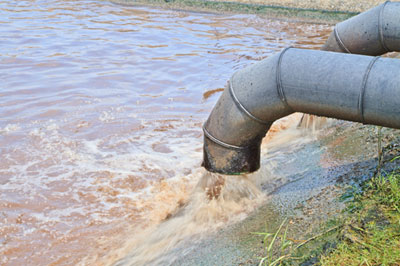 New extraction techniques based on hydraulic fracturing and horizontal drilling have significantly increased the available oil and gas in the United States. Producing oil and gas from shale formations is the main source of these unconventional resources. When shale formations are hydraulically fractured to increase the permeability, up to 5 million gallons of water can be used for each well. The significant use of water has caused concerns by several stakeholders, particularly in regions that are constantly facing water shortages such as Texas and Colorado. After the well is fractured, large amounts of water return as frac flowback and then, after the well is put into production, water that is coproduced with oil and gas must be collected for the life of the well. The produced water has hazardous characteristics (it has been in contact with oil and gas for millions of years) and disposal or reuse is an important concern. Current produced water management includes underground injection, surface disposal or reuse. Owing to a large amount of total dissolved solids (TDS), metals and hydrocarbons (e.g. BTEX) in produced water, the brine needs to be treated to achieve acceptable water quality for subsequent disposal or reuse. Reuse of produced water for drilling and fracturing after appropriate treatment has multiple advantages, including less truck traffic and lower fresh water demands. The objective of the project described in this presentation was to integrate the OLI chemical equilibrium model into the OFM (Oil Field Management) tool framework to allow chemical equilibrium calculations to be made for each well and in the aggregate throughout the Wattenberg oil and gas field of northern Colorado. The calculations from this model can then be used as design criteria for treatment train definition, based on the desired water disposal outcome. OLI Systems software was developed for the oil and gas industry and is well suited as a module for calculating chemical equilibrium values for produced water and frac flowback water. The presentation will include predictions of equilibrium chemistry, solids precipitation, scaling index, based on water quality data collected in the field. The model can also predict requirements for combining and treating produced water streams to achieve process objectives. At the same time, water quality will be analyzed after detailed sampling from various parts of the field. Finally, water quality after precipitation, settling and filtration has been used to estimate the osmotic pressure and design reverse osmosis processes for different levels of TDS rejection. This will be integrated with a customized ArcGIS tool which will help in predicting the flow of produced water. It will also help optimize travel logistics and determine optimal locations for produced water treatment plants.
New extraction techniques based on hydraulic fracturing and horizontal drilling have significantly increased the available oil and gas in the United States. Producing oil and gas from shale formations is the main source of these unconventional resources. When shale formations are hydraulically fractured to increase the permeability, up to 5 million gallons of water can be used for each well. The significant use of water has caused concerns by several stakeholders, particularly in regions that are constantly facing water shortages such as Texas and Colorado. After the well is fractured, large amounts of water return as frac flowback and then, after the well is put into production, water that is coproduced with oil and gas must be collected for the life of the well. The produced water has hazardous characteristics (it has been in contact with oil and gas for millions of years) and disposal or reuse is an important concern. Current produced water management includes underground injection, surface disposal or reuse. Owing to a large amount of total dissolved solids (TDS), metals and hydrocarbons (e.g. BTEX) in produced water, the brine needs to be treated to achieve acceptable water quality for subsequent disposal or reuse. Reuse of produced water for drilling and fracturing after appropriate treatment has multiple advantages, including less truck traffic and lower fresh water demands. The objective of the project described in this presentation was to integrate the OLI chemical equilibrium model into the OFM (Oil Field Management) tool framework to allow chemical equilibrium calculations to be made for each well and in the aggregate throughout the Wattenberg oil and gas field of northern Colorado. The calculations from this model can then be used as design criteria for treatment train definition, based on the desired water disposal outcome. OLI Systems software was developed for the oil and gas industry and is well suited as a module for calculating chemical equilibrium values for produced water and frac flowback water. The presentation will include predictions of equilibrium chemistry, solids precipitation, scaling index, based on water quality data collected in the field. The model can also predict requirements for combining and treating produced water streams to achieve process objectives. At the same time, water quality will be analyzed after detailed sampling from various parts of the field. Finally, water quality after precipitation, settling and filtration has been used to estimate the osmotic pressure and design reverse osmosis processes for different levels of TDS rejection. This will be integrated with a customized ArcGIS tool which will help in predicting the flow of produced water. It will also help optimize travel logistics and determine optimal locations for produced water treatment plants.